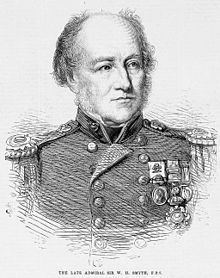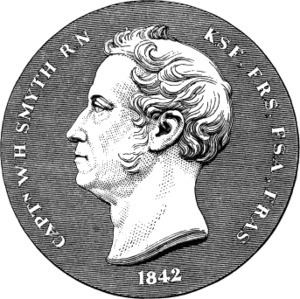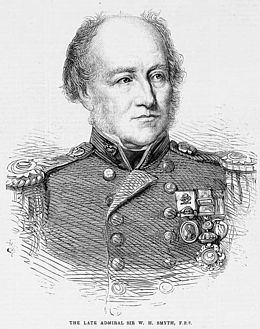Rank Admiral Name William Smyth | Role Astronomer Years of service 1804–1846 Grandparents Laetitia Pilkington | |
 | ||
Born 21 January 1788Westminster, London ( 1788-01-21 ) Died September 8, 1865, Aylesbury, United Kingdom Parents Georgina Caroline Pitt Pilkington Children Charles Piazzi Smyth, Henry Augustus Smyth Books The Sailor's Word‑boo, A Cycle of Celestial Objects, The Sailor's Word: A, Sidereal chromatics, The Mediterranean: A Memoir | ||
Admiral William Henry Smyth (21 January 1788 – 8 September 1865) was an English naval officer, hydrographer, astronomer and numismatist. He is noted for his involvement in the early history of a number of learned societies, for his hydrographic charts, for his astronomical work, and for a wide range of publications and translations.
Contents
- Family
- Royal Navy
- Astronomical and other work
- Involvement with learned institutions
- Publications
- References

Family

William Smyth was born at 42 Great Peter Street, Westminster, London. He was the only son of Joseph Smyth and Georgina Caroline Pitt Pilkington, granddaughter of the Irish writer Laetitia Pilkington and her husband Matthew Pilkington, both protégés of Jonathan Swift.
William Smyth's father, Joseph Brewer Palmer Smyth, was born in 1737 in New Jersey, the son of Benjamin Smyth (born 1700 in Woolpack, New Jersey, died 1769, in Knowlton, N.J.), himself the son of Benjamin Smyth (died 1720). Joseph was a colonial American and a merchant and land owner in Knowlton, Sussex, New Jersey. He was a British loyalist and in January 1777 he was commissioned as Lt in the King's Royal Regiment of New York. However, he escaped to Niagara at the start of the American Revolution. In November 1778 he sailed for New York, but was captured. He eventually reached Falmouth, Cornwall, in January, 1779 "in a most forlorn condition", destitute and suffering from fever and smallpox. In 1780 he married Georgina Pilkington in England. He was in Niagara in 1788.
William Smyth, his son, was born on 21 January 1788, shortly before Joseph died in Quebec between February and July 1788. William's half brother was the famous painter and traveller Augustus Earle.
William Smyth married Eliza Anne "Annarella" Warington in Messina on 7 October 1815, when they were 27. Smyth and Annarella had eleven children between 1816 and 1835. Their three sons were Charles Piazzi Smyth, Sir Warington Wilkinson Smyth and General Sir Henry Augustus Smyth. Of their eight daughters, two died young (their first-born, Elizabeth, aged 4 and fourth-born Elizabeth Ann aged 2), a third (Jane Phoebe) "married and died" aged 20, another (Josephine) also died at 20, unmarried, and another (Caroline Mary) at 25, of diphtheria, less than a month before her wedding day. Their other three daughters were Henrietta Grace, who married Rev. Professor Baden Powell and was mother of nine, including Robert Baden-Powell, 1st Baron Baden-Powell; while Georgiana Rosetta married Sir William Henry Flower and had seven children; and Ellen Philadelphia, who married Capt. Henry Toynbee and sailed out to Australia as a bride in 1855. She died childless in 1881 aged 52 after a long illness.
Smyth suffered a heart attack at his home near Aylesbury in early September 1865, and at first seemed to recover. On 8 September he showed the planet Jupiter to his young grandson, Arthur Smyth Flower, through a telescope. He died a few hours later, in the early morning of the 9 September 1865, aged 78. He was buried in the churchyard at Stone near Aylesbury.
Royal Navy
At the age of 14 Smyth ran away to join the merchant marine. In 1804 he was in the East India Company's ship Marquis Cornwallis, which the government chartered for an expedition against the Seychelles. In the following March Cornwallis was bought into the navy and established as a 50-gun ship under the command of Captain Charles James Johnston, with whom Smyth remained, seeing much active service in Indian, Chinese, and Australian waters. In February 1808 he followed Johnston to the Powerful, which, on returning to England, was part of the force in the expedition to the Scheldt, and was paid off in October 1809. Smyth afterwards served in the 74-gun Milford on the coast of France and Spain, and was lent from her to command the Spanish gunboat Mors aut Gloria for several months at the defence of Cadiz (September 1810 to April 1811). In July 1811 he joined Rodney off Toulon, and through 1812 served on the coast of Spain.
On 25 March 1813 he was promoted to the rank of lieutenant, and appointed for duty with the Sicilian flotilla, in which he combined service against the French from Naples with a good deal of unofficial hydrographic surveying and antiquarian research. For his services in defending Sicily Smyth was subsequently awarded the Order of Saint Ferdinand and of Merit by King Ferdinand I of the Two Sicilies, and received permission from the Prince Regent to wear it on 16 March 1816.
On 18 September 1815 he was made commander, and without any appointment to command a ship he continued surveying the coast of Sicily, the adjacent coasts of Italy, and the opposite shores of Africa.
With his military commitments coming to an end with the fall of Napoleon, Smyth devoted himself to the survey of Sicily, in command of the brig Scylla, and he produced a number of maps and drawings that roused the Admiralty's unconditional admiration for their beauty and accuracy.
He was subsequently engaged in hydrographic operations in the Adriatic, collaborating with the Austrian and Neapolitan authorities in the production of loose charts and of the Carta di Cabottaggio del Mare Adriatico ("Cabotage map of the Adriatic Sea"), published in 1822–24.
During this period (1815–1817), Smyth's 22-year-old half-brother, Augustus Earle, visited Sicily, Malta, Gibraltar and North Africa. Smyth had sought and was given permission by Lord Exmouth to allow Augustus passage through the Mediterranean aboard the Scylla that he commanded and which was part of Admiral Lord Exmouth's Royal Navy fleet.
In 1817 Smyth's survey work was put on a more formal footing by his appointment to Aid (renamed in 1821 as Adventure). This ship was later to be accompanied by Beagle on the first "voyage of the Beagle" (1826–30). Charles Darwin was on the second voyage, 1831–36, on which voyage, Smyth's half-brother Augustus Earle was appointed 'ship's artist' by naturalist Charles Darwin. In this capacity he acted as both a recorder of biological specimens and as topographical artist.
In Aid, Smyth carried on the hydrographic survey of the Italian, Sicilian, Greek, and African coasts, and constructed a very large number of charts, used by the British Royal Navy inter alia until the mid 20th century. As a result, he became known as "Mediterranean Smyth"; an 1818 portrait exists.
In 1817 he met the Italian astronomer Giuseppe Piazzi in Palermo, Sicily, and visited his observatory; this sparked his interest in astronomy. Smyth's first son was given Piazzi's surname as his middle name.
Smyth published some of this work in his elaborate Memoir … of the Resources, Inhabitants, and Hydrography of Sicily and its Islands (London, 1824), which was to be followed in 1828 by a Sketch of Sardinia.
On 7 February 1824, Smyth was promoted to post rank, and in the following November, aged 37, he paid off the Adventure. As a result of the inevitable cuts following the defeat of Napoleon, this was the end of Smyth's service at sea, his tastes then leading him to a life of literary and scientific industry.
In 1846 Smyth accepted retirement from the Navy, receiving half-pay of 18 shillings per day, though in due course he was advanced, on the retired list, to rear-admiral ("without increase of pay") on 28 May 1853, then to vice-admiral on 17 May 1858 (with seniority from 13 February), and finally to admiral on 14 November 1863.
He was awarded the Royal Geographic Society's Founder's Medal in 1854 for his survey work in the Mediterranean.
Astronomical and other work
In 1825 Smyth established a private observatory in Bedford, England, equipped with a 5.9-inch refractor telescope. He used this instrument to observe a variety of deep sky objects over the course of the 1830s, including double stars, star clusters and nebulae. He published his observations in 1844 in the Cycle of Celestial Objects, which earned him the Gold Medal of the Royal Astronomical Society in 1845 and also the presidency of the society. The first volume of this work was on general astronomy, but the second volume became known as the Bedford Catalogue and contained Smyth's observations of 1,604 double stars and nebulae. It served as a standard reference work for many years afterward; no astronomer had previously made as extensive a catalogue of dim objects such as this. It was reprinted in 1986, and in the Foreword to that edition George Lovi (astronomer and writer) writes, "What makes it so special is that it is the first true celestial Baedeker and not just another "cold" catalogue of mere numbers and data. Like the original Baedeker travel guidebooks of the last century, this work is full of colorful commentary on the highlights of the heavenly scene and heavily influenced several subsequent works of its type, even to the present day. ...It is in the descriptive material that Smyth is a delight. He not only describes what the user of a small telescope will see, but also includes much fascinating astronomical, mythological, and historical lore. Many of these descriptions are especially valuable for the novice and user of small telescopes of a size similar to Smyth's."
Having completed his observations, Smyth moved to Cardiff in 1839 to supervise the construction of the Bute Dock which he had designed (see his Report, of which a copy is held at the Institution of Civil Engineers). His observatory was dismantled and the telescope was sold to Dr John Lee and re-erected in a new observatory of Smyth's own design at Hartwell House nearby.
Smyth moved to Stone near Aylesbury in 1842, and still had the opportunity to use the telescope since his residence at St. John's Lodge was not far from its new location, and he performed a large number of additional astronomical observations from 1839 to 1859. The telescope is presently in the Science Museum, London. (See his book "Aedes Hartwellianae, or notices of the Mansion of Hartwell" (1851), which has illustrations by his wife Eliza, his sons Charles and Henry, his daughter Ellen, and his son-in-law, Rev. Professor Baden Powell.)
Smyth also produced observations and publication on star colours entitled "Sidereal Chromatics" in 1846, which attempted to explain the nature, effects of the Earth's atmosphere, and the possibility of the changing of these colours (as variable coloured stars) due to their Doppler shifts. Whilst the premise proved ultimately wrong, he discusses and creates a summary on observing star colours of many double stars, under his so-called Hartwell Experiment. Some of these ideas continued to be promoted into the early 20th Century, but were mostly soon replaced then rejected by the overwhelming evidence by astronomical spectroscopy.
Smyth was a numismatist of some standing, being a founding member of the Royal Numismatic Society in 1836. He maintained a lifelong interest in coins and was author of a number of interesting treatises on the subject. The history of the Society, Part 1: 1836–1874, describes the founding of the Society including the role of Admiral Smyth: :The first meetings, held on 26 June 1836 ... proposed that ... the friends of Numismatic Science should ... be formed into ... the Numismatic Society, that Capt. William Henry Smyth be requested to act as President. In the event, he became instead one of the first Members of Council.
An 1861 portrait in oils by E. E. Eddis of him, with his wife, cataloguing the Duke of Northumberland's numismatic collection, was destroyed during the London blitz, but prints exist. That catalogue was used when the Duke's collection was sold.
Smyth latterly also had a house at No. 3 Cheyne Walk, Chelsea, where he stayed while attending the various learned societies, and where he entertained his like-minded friends, of whom Rev. Professor Baden Powell was one, and who, on the 10 March 1846, when he was 50, became Smyth's son-in-law, although only eight years younger, by marrying Smyth's daughter Henrietta Grace, then aged 22.
Involvement with learned institutions
In 1821 he became a fellow of the Society of Antiquaries of London and of the Royal Astronomical Society (RAS). On 15 June 1826 he was elected Fellow of the Royal Society, and in 1830 was one of the founders of the Royal Geographical Society (RGS). In 1845–6 he was president of the RAS; in 1849–50, of the RGS; he was vice-president and foreign secretary of the Royal Society; vice-president and director of the Society of Antiquaries; and was honorary or corresponding member of at least three-fourths of the literary and scientific societies of Europe. as well as societies in the United States. Among these were the Royal Irish Academy, the Institut de France, the Accademia Pontaniana, the National Institute of Washington, the American Academy of Arts and Sciences (1847), and the Naval Lyceum of New York. He also served on the Board of Visitors to the Greenwich Observatory. He contributed numerous papers to the Philosophical Transactions and the Proceedings of the RAS and RGS, and from 1829 to 1849 to the United Service Journal, and was the author of many volumes, the best known of which are The Cycle of Celestial Objects for the use of Naval, Military, and Private Astronomers (2 vols. 1844), for which he was awarded the gold medal of the Royal Astronomical Society; The Mediterranean: a Memoir Physical, Historical, and Nautical (1854); and The Sailor's Word-Book, revised and edited by Sir Edward Belcher (1867). He also translated and edited François Arago's treatises on Popular Astronomy and on Comets. The complete story of his literary activity is contained in Synopsis of the published and privately printed Works of Admiral W. H. Smyth (1864), which enumerates his fugitive papers as well as his larger works.
A lunar mare was named Mare Smythii in his honour, as was Cape Smyth in the Antarctic.
His obituary in the Monthly Notices of the Royal Astronomical Society noted:
As President of the Astronomical Club, he was always genial & courteous, ever keeping things in happy order, and by his ready wit and flow of humour compelling the maintenance of good fellowship. He used to fill his pockets with new half-pennies to distribute to any children he met in his daily walks. Whatever he did, he did it with his might.